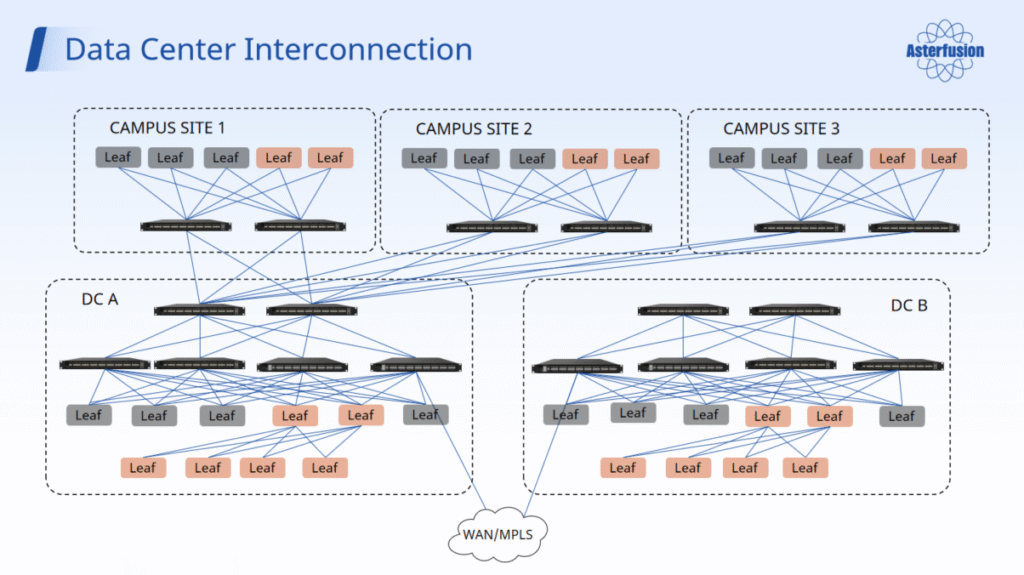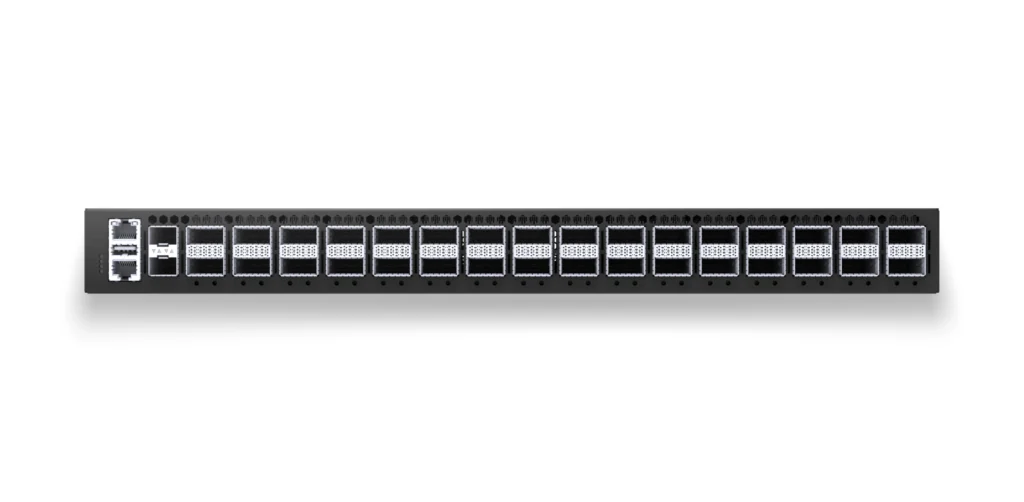Ultra-Low Latency Live Streaming with Asterfusion PTP and VXLAN Multicast: North America & Japan Case Study Ⅱ
written by Asterfuison
Table of Contents
Introduction
This article continues from Case Study Ⅰ and presents the network architecture and deployment solutions for Live Streaming with PTP, implemented for a top-three media live streaming customer in the United States and a broadcasting client in Japan.
Topology Overview

This topology represents a simplified view of the network designed for Live Streaming with PTP.
It consists of a primary and a backup data center, along with three edge campus sites (CAMPUS SITE 1–3) to improve geographic redundancy and reduce latency. The network adopts a Leaf–Spine architecture combined with a BGP EVPN control plane, leveraging VXLAN multicast to achieve highly efficient traffic distribution and scalable bandwidth utilization.
At the Leaf layer, Asterfusion 1G and 10G devices handle burst traffic during live streaming. They also support diverse bandwidth needs, from standard office applications to high-bitrate 4K and 8K ultra-high-definition live video streams.
The Spine layer uses high-performance switches such as the Asterfusion Falcon CX732Q-M-H, which serve as boundary clocks, supporting PTP Class C (<10 ns) to provide high-precision time synchronization across multiple network nodes and devices.
Key Technologies for Live Streaming with PTP
- PTP Boundary / Transparent Clock: As defined in IEEE 1588, it provides precise time synchronization across the entire network, meeting Class C (<10 ns) requirements. In multi-camera live streaming, it ensures that video, audio, and audience interactions remain precisely time-aligned across all feeds, avoiding frame misalignment or interaction delays.
- VXLAN Multicast BUM Forwarding: Efficiently handles all non-unicast traffic, such as live stream multicast, within the VXLAN overlay network. It uses the Underlay network to replicate packets efficiently, reducing the need for repeated copies at the source VTEP and improving overall transmission efficiency for high-bandwidth video streams.
- VXLAN Technology: Network virtualization isolates different live streaming projects, test environments, and office networks, preventing interference and ensuring data security and stability in a multi-tenant environment.
- EVPN Multi-Homing: Provides redundant network paths for the access side. Any single point of failure—such as a disconnected cable, switch outage, or hardware failure—does not interrupt service, significantly enhancing overall network resilience.
When viewed from the physical layer up to the service layer, each network layer is designed to fully support the requirements of live streaming with PTP.
- Physical Layer: DCs and campus sites are connected via low-jitter, low-latency dedicated links, providing a solid foundation for precise PTP time synchronization and consistent live video and interaction timing.
- Underlay Layer: Runs IGP to establish IP connectivity and enables PIM-SM multicast, allowing Spine switches to replicate multicast traffic efficiently. Each VXLAN segment maps to a dedicated PIM multicast group for precise traffic delivery.
- Overlay Layer (VXLAN): Leaf switches (VTEPs) encapsulate L2 BUM traffic into VXLAN. The Underlay multicast network handles replication, so source Leafs do not need to duplicate packets, improving efficiency for high-bandwidth live streams.
- Control Plane (EVPN): BGP EVPN exchanges MAC and VNI information. Combined with Underlay multicast, it creates a complete VXLAN EVPN network capable of flexible cross-domain live stream distribution.
- Service Layer: Live video distribution and PTP time synchronization run directly over the VXLAN Overlay network. The Underlay PIM multicast network ensures accurate multicast replication and latency alignment, delivering a smooth and fully synchronized live streaming experience.
Results of Live Streaming with PTP Deployments
The solution has been successfully deployed. Asterfusion switches support 288K L2/L3 multicast shared entries, typically accommodating 48K multicast groups in standard configurations, fully meeting the customer’s multicast requirements.
It is already in commercial use in North America and Japan, where its stability and performance have been validated for Live Streaming with PTP.
For more details, please refer to Ultra-Low Latency Live Streaming with Asterfusion PTP and VXLAN Multicast: North America & Japan Case Study Ⅰ.






